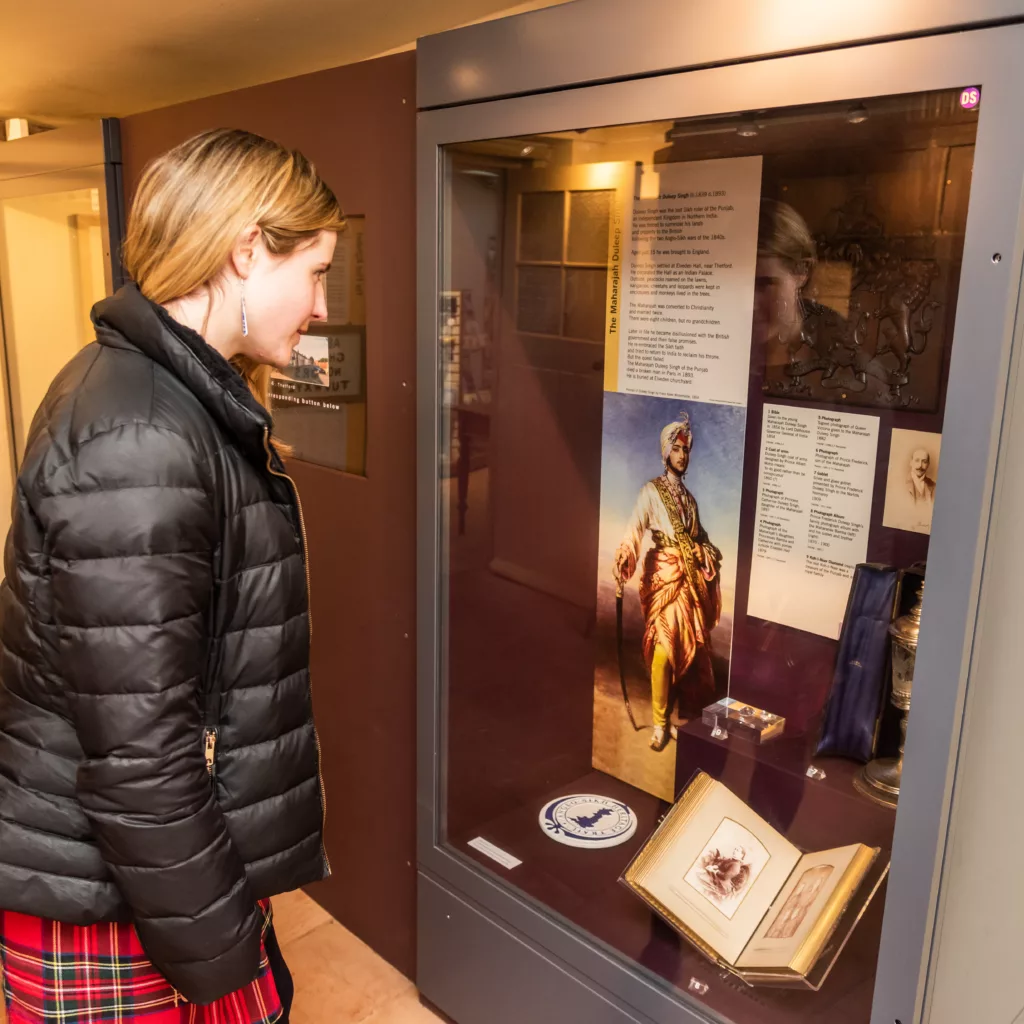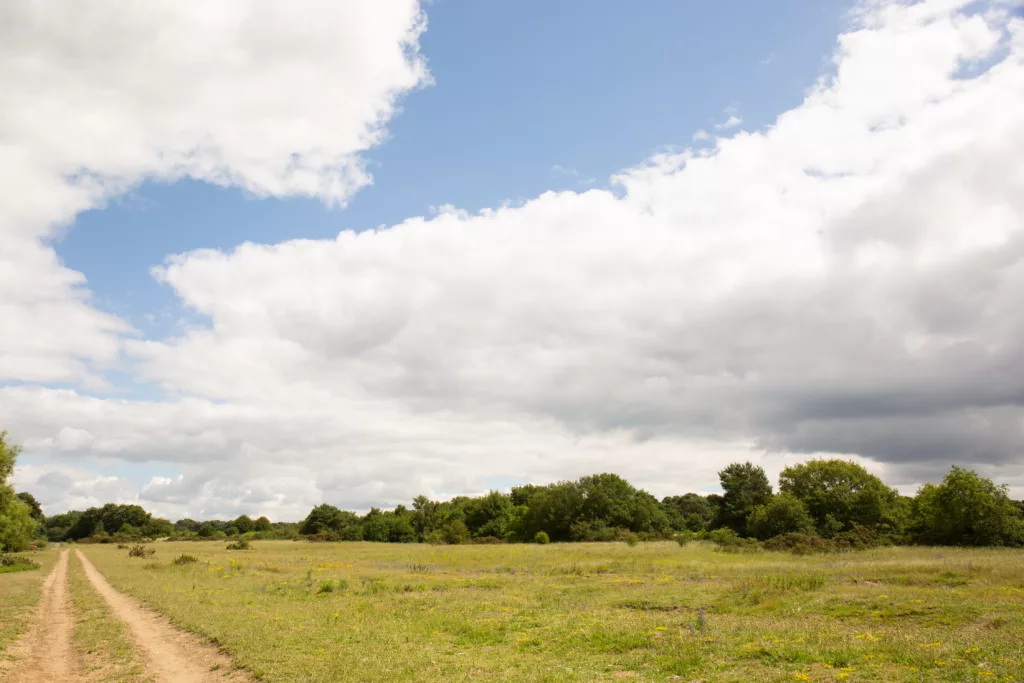
Thetford Ancient House
There are many magnificent stately homes in Norfolk but the charming Ancient House Museum in Thetford gives a unique glimpse into the history of middle class life. The early Tudor town house is one of the best examples in East Anglia. Its origins are uncertain but when the house was given as a gift to the town by Prince Frederick Duleep Singh in 1921, a conveyance mentions it was erected in the reign of Edward IV (1461-83). Probably commissioned by a wealthy merchant, it’s likely the house was originally detached, albeit constrained by the modest size of the plot.
Unlike in dramas like ‘Downton Abbey’, it was common for this kind of household, including servants, to sit down and eat together. The comfortable interior, with beautifully carved timbers, immediately captures the imagination. The Museum examines the lives of various people who lived in this building; an innkeeper, a plumber, a watchmaker and a museum caretaker. The 1901 population census tells us Thomas Newton, a rabbit warrener, was living here with his wife Emily, their family and four lodgers. If you love The Museum of the Home in London’s Shoreditch, Thetford’s Ancient House is a must-see.
Nearby there’s more history to discover. In 1737 political philosopher Thomas Paine was born 100 metres away. A passionate supporter of American and European revolutionary causes, he wrote hugely influential pamphlets including Common Sense, Age of Reason and the Rights of Man, a rebel in the great tradition of Norfolk’s radical thinkers!

Dad’s Army Museum Thetford
Anyone who loves the nostalgic wartime BBC TV comedy Dad’s Army may well recognise the buildings of Thetford and countryside as the real life location of Warmington-on-Sea, the fictional town under the protection of Captain Mainwaring’s shambolic Home Guard. In its heyday the series regularly gained audiences of 18 million viewers and is still shown internationally and on Britbox.
Thetford’s Guildhall doubled as the Warmington-on-Sea town hall and many scenes were filmed in the town or surrounding countryside. Between 1968 and 1977 Captain Mainwaring, Corporal Jones, Private Pike, Wilson and other cast members were familiar faces in Thetford. If you stay at The Bell Inn, you might even get the same room as your favourite character, or at least one named after them. No need to dig through the archives to find the film locations, just book a guided walking tour round town or coach tour to explore even further afield. When the Dad’s Army Tours were launched they proved so popular that a Dad’s Army Museum was founded in the Old Fire Station. Fans will love all the memorabilia including Jones’s Butcher van, housed at the nearby Charles Burrell Museum. Have a photo taken in the Vicar’s chair or settle into 1940s inspired Marigold’s Tea Room for a nice cup of tea and wartime style cake – but no powdered egg! Or walk down the riverbank and take a picture beside a life size statue of Captain Mainwaring or a mural of Private Pike. Forgot your camera? You stupid boy!

Princess Catherine Singh – the ‘Sikh Schindler’
In the Breckland town of Thetford there is a statue of Duleep Singh, the last Maharajah of Punjab. His story is astonishing enough, however, his daughters were no less remarkable. Like her sister Sophia, Princess Catherine Singh ardently campaigned for Votes for Women. Catherine was a suffragist, undoubtedly a supporter of the 1913 Women’s Suffrage March when women from all over Britain converged on Hyde Park, with one protest march starting in Cromer, through Norwich and Thetford and onwards to London. But female empowerment was not the only expression of Catherine’s courage.
In 1908, Catherine moved to Germany to live with Lina Schäfer. The ‘intimate’ couple lived in Munich and Kassel, described by Lina as ‘two little mice living in a little house’. However their quiet life was threatened when Hitler seized power and the Nazis made it clear they ‘disapproved of the old Indian lady’, who lived with another woman. In 1938 Lina died. Catherine sold everything and left Germany.
Author and historian Peter Bance discovered a secret side to Catherine’s life. She saved many Jews from the Nazis. Families she helped included Dr Hornstein, rescued from the Oranienburg Concentration Camp, violinist Alexander Polnarioff and the Meyerstein family. During the war Catherine took German-Jewish refugee families into her Buckinghamshire home and opened it to evacuees escaping the Blitz. The story of the woman known as the ‘Sikh Schindler’ is an extraordinary legacy of courage and trail-blazer for LGBTQIA+ people of South Asian heritage.

Thetford Castle
In the historic market town of Thetford stands the largest earthen motte in England. Climb 40 feet and 90 steep steps to the top to see for miles across Norfolk. Here, a Norman castle once dominated the town, erected inside an ancient Iron Age earthworks. Standing at the crossings of the rivers Thet and Ouse, the Iceni tribe hill fort, dating from around 500BC, oversaw Ickneild Way, ‘the oldest road in England’. The 4,000 year old trackway connects Dorset to Norfolk along the chalk spine of England, George R.R. Martin’s inspiration for the Kingsroad in Game of Thrones.
The Domesday Book notes Thetford was England’s sixth largest town a strategic site for a Norman motte and bailey castle, believed to have been constructed in 1067, immediately after the Norman Conquest. Topped by a wooden tower encircled by a timber palisade, the Norman castle was probably built by Ralph Guader, Earl of East Anglia until he led an unsuccessful Revolt of the Earls against the Crown 1076. Or by his successor Roger Bigod (Baron Bigod cheese is named after his lordly lineage).
Only Silbury Hill in Wiltshire has a larger human-made mound, and Thetford’s is just as rich in mystery and legend. Medieval locals called it Devil’s Dyke, formed by mud falling from Satan’s filthy hoof. Others claim a king’s palace, full of treasure, lies under the hill or that six silver bells from Thetford Priory were hidden here during the Reformation, still buried deep in Norfolk earth.

Grimes Graves
Tucked away in majestic Thetford Forest there’s a mysterious lunar landscape, as if a huge meteorite shower once pounded the Breckland heath. Precisely 433 craters spread over 90 acres, strange hollows that seem hammered by a Norse god. No, not the mighty Thor but his pal, Odin. Odin’s Anglo-Saxon name is Woden, nicknamed Grim. Hence, Grimes Graves.
So was this fascinating place really created by ancient gods? The truth is, this heritage site was a Neolithic flint mine, made by humans some 5,000 years ago. In the days before our ancestors forged metal, super sharp flints were ‘knapped’ into tools, weapons and ceremonial objects. At Grimes Graves miners dug vertical shafts up to 13 metres deep and excavated narrow galleries which they crawled along, gouging out flint with pickaxes made from deer antlers. But what else might have taken place down in those dark tunnels? Animal bones and even a human skull have been found, along with evidence of underground fires, suggesting this was once a place of sacred rituals. And it’s likely what you see today is only part of the subterranean labyrinth which probably extended far under the pine forest.
Visitors can descend 9 metres (30 ft) by ladder into an excavated shaft to see the jet-black flint, which is itself another layer of deep time. Flint is the fossilised remains of soft-bodied sponges once swimming in the warm Cretaceous seas which, millions of years ago, covered the very place you now stand.

Tea Walk at Brandon Park
How peaceful to take deep, slow breaths wandering among the tall pines of Brandon Country Park! Forest bathing, or shinrin-yoku, is the ancient Japanese practice of walking slowly and intentionally in the woods, absorbing their quiet healing powers. Cool, lemony pine is a particularly calming fragrance for mind, body and spirit. So good you could drink it! We’re not even joking…herbalists and indigenous peoples have been brewing pine needle tea for centuries. It’s the perfect natural remedy for winter sniffles, a known decongestant and expectorant with anti-inflammatory and antimicrobial properties to boot!
So take a thermos flask of boiled water on woodland walks and you’ll be ready for an impromptu foraged brew!
The Eastern White Pine (Pinus strobus) makes fabulous tea and is easily identified by clusters of 5 long needles growing brush-like from each branch. WARNING! Some conifers are toxic to humans so, as with all foraging, be 100% certain you’re taking the needles from the right kind of tree and don’t leave room for any doubt.
Once you’re sure it’s safe, gather your needles and perch on a sheltered tree stump to rustle up a brew. Here’s how:
- take a fist full of clean, green pine needles
- snip them into small pieces (discard the brown bit holding the cluster together)
- Steep the chopped needles covered by 2 cups of boiled water (take a thermos flask)
- Leave 10-15 minutes
Strain, sweeten with honey if you fancy. Thank the trees. Breathe deeply. And enjoy.

The Sikh Suffragettes
If you’re a woman who honours her hard-won right to vote, you’ll know about Mrs Pankhurst. You may be less familiar with two remarkable women from Thetford who played central roles in the ‘advancement of women’ through women’s suffrage. And you might be surprised to hear both were Indian princesses whose godmother was Queen Victoria. Sophia and Catherine were the daughters of the Maharajah Duleep Singh, last Sikh ruler of the kingdom of Punjab. British colonial rule forced the surrender of his lands and possessions (including the Koh I nor diamond), so he came to Britain, was befriended by Queen Victoria and settled into life at Elveden Hall, near Thetford, where Sophia and Catherine Duleep Singh were born.
Catherine joined the Fawcett Women’s Suffrage Group. Sophia became part of Emmeline Pankhurst’s more militant inner circle, often on the front line of marches and protests like the Black Friday demonstration to Parliament, she funded suffragette groups and refused to pay taxes recounting the slogan ‘No Vote, No Tax’. Sophia went to court several times for non-payment of licence fees covering, amongst other things, keeping dogs, carriages and servants and in lieu of court fines had a diamond ring seized by bailiffs. King George V asked in exasperation, ‘Have we no hold on her?’ Apparently not!
In 1921 Sophie’s brother, Frederick, founded the Ancient House Museum in Thetford town centre. Visit this stunning building to learn more about the bold sisters who fought the establishment for women’s right to vote.

A Breckland Heath
After the First World War the British Government kicked off a massive national drive to plant huge blocks of coniferous trees for secure supplies of home-grown timber.
The sweeping sandy heathlands of the Brecks were no use for farming, good only for grazing sheep and rabbits. But they were prime real estate for millions of trees. Planting began around Thetford, eventually transforming the open grasslands to huge tracts of forest. First cleared by prehistoric farmers, wild expanses of the original heathland are rare and very special to explore.
Of the 12,550 wildlife species in the Brecks, 30% are nationally rare and some can be found only on these unique heaths. Just over the border in Suffolk is Knettishall Heath, and Norfolk’s Brettenham Heath is a 200-hectare National Nature Reserve, on chalk bedrock, tens of metres thick, laid down during the Cretaceous period.
In some places the rock is close to the surface, breaking through the sandy soil. Where the soil is thicker it also becomes slightly more acidic, subtly changing the variety of plants and wildlife. This part of Norfolk was free of ice during the most recent glacial period resembling a treeless northern tundra or steppe. Part of a mosaic of heaths, forests and farmland, Brettenham is a beautiful place for a winter walk. And if you love Geology, head for the central and eastern part of the heath, where one of the country’s best examples of acid soil and polygons of chalk can be seen.
Build your own itinerary
If you fancy creating your own itinerary for a day trip to Norfolk or a longer visit, it couldn’t be simpler. Just go to Search Activities and select from our wide range of free and paid-for experiences, saving any that capture your imagination with the click of a button.
Once you’ve finished, you’ll find all the information stored in My Favourite, where you can drag and drop activities to create your own day-by-day itinerary! You can download this to a calendar and even share it with friends.
